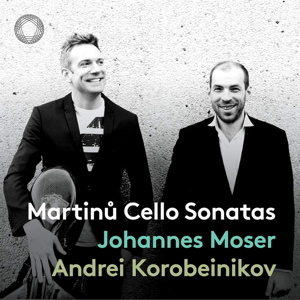
Bohuslav Martinů (1890-1959)
Cello Sonata No 1, H277 (1939)
Cello Sonata No 2, H286 (1941)
Cello Sonata No 3, H340 (1952)
Johannes Moser (cello)
Andrei Korobeinikov (piano)
rec. 2022, Recording Studio Drenthem, Valthermond, Netherlands
PENTATONE PTC5187007 [59]
Martinů’s Cello Sonatas are becoming staples of the recorded discography even if they appear in concert recitals less frequently. The three are compact and agreeably sized – all in three movements between 16 and 21 minutes in length – and with a suitable coupling or (as here) no coupling, they can still fit a CD perfectly.
The latest to enter the ‘sonata cycle’ are Johannes Moser – who has recorded Martinů’s First Cello Concerto for Hänssler – and Andrei Korobeinikov, recorded in the Dutch countryside in March 2022. They programme the sonatas 2, 1, 3 but I’ll review them in the order of composition, starting with the First, composed in 1939. The ensemble between the two musicians is excellent and they’ve clearly had time to consider the three sonatas and their emotive trajectory from the anxious First to the celebratory, reflective Third. What the twosome lack is a degree of percussive tension, such as one finds in the classic Starker-Firkušný recording The First emerges as slightly horizontal in comparison but their rumination in the slow movement is fine, their tempo in the finale well judged. It was composed in France and first performed by Pierre Fournier and Firkušný.
The Second Sonata of 1941 again opens with the piano that establishes the intensity and volatility of the music’s direction. Thenceforth both musicians bring colour and subtlety to bear – Moser’s classy use of right-hand shading through his bowing is very noticeable. The melancholic central movement is desolate in places whilst the typically arresting Martinů-stamped figures in the finale are clearly relished, the performance up to tempo but sufficiently flexible through use of cannily deployed rubato.
Written in memory of the composer’s friend, the Dutch cellist and conductor Hans Kindler in 1952, the final sonata immediately establishes a new clarity and freedom in its initial ‘open’ chords which create a more avuncular and extrovert aura. The Polička bells ring out in the piano, the music bringing a celebratory warmth and vitality too. Moser and Korobeinikov capture this new feeling well but at slightly greater length than, say, Starker and Firkušný. So, too, they find the nobility and chorale-like strength in the central movement and the off-kilter rhythms in the finale, the lissom neo-classicism as well.
In a previous review I characterised some of the recent recordings of these sonatas so, assuming you’ve never read that review, here’s a reprise for convenience’s sake; glib, maybe, but I think accurate. Stephen Isserlis’ second cycle (review) with Olli Mustonen on BIS was fast and furious, the Watkins Brothers on Chandos are tough and abrasive (review), Mattia Zappa and Massimiliano Mainolfi on Claves (review) are defiant but their recorded sound is unhelpfully glacial, whilst Petr Nouzovský and Gérard Wyss on Arco Diva (review) are quite reserved. Raphael Wallfisch and John York in the latest of a fine sequence of sonata discs on Nimbus (review) are eloquent but a touch underpowered at certain points.
So where do the Moser-Korobeinikov duo stand? Pretty high, I’d say. Their take is warmly recorded and technically adroit. They have consistent purpose and fine ensemble. They are not as tensile as Starker and Firkušný, the go-to choice still, but I certainly prefer them to Isserlis and Mustonen; Isserlis’ earlier recording with Peter Evans for Hyperion was arguably superior to his later version. I’ve always had a soft spot for the Josef Chuchro-Josef Hála recording of 1983 though they’re not the speediest, if that’s your yardstick.
So, with a couple of reservations about a lack of incision, I think this latest well-recorded disc would make a more-than-acceptable acquisition.
Jonathan Woolf
Help us financially by purchasing from





















